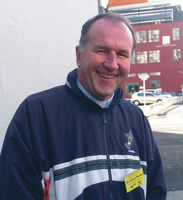
Some say that pilgrimages to that area are more ancient, that it was a trail the dead followed as they departed Europe. Near Compostela is the Atlantic ocean at Finisterre (land’s end). The departed would head west across the sea towards the setting sun.
How did St James get to Spain? After the resurrection of Jesus the apostles went to different places to spread the gospel. St James the Elder was reputed to have gone to Spain although the Acts of the Apostles (ch 12) has him dying in Jerusalem. The story in Spain was that James was temporarily back in the Holy Land on pilgrimage when he was killed. His bones were later brought back and buried in Compostela. They lay undiscovered until about 813.
This discovery was fortuitous for the local kings who were trying to reconquer lands overtaken by the Muslim Moors from North Africa. The Moors had conquered most of the Iberian peninsula except for a small portion in the very north. This area managed to free itself relatively quickly. It was from this area that the Reconquest of Spain began. With the discovery at Compostela, St James became patron saint of the campaign.
The Reconquest is a grand name for a long and complex process. The Spanish Catholic forces were often fighting each other as much as the Moors and mercenaries from both sides fought for the highest bidder. There was also much ordinary interaction between Muslims, Christians and Jews. In 1492 the Reconquest was completed when Ferdinand and Isabella, ‘the Catholic Royals’, drove the Moors from Granada in south-eastern Spain.
Santiago de Compostela became a place of pilgrimage as an alternative to Rome or the Holy Land. As patron saint of Spain, St James is often depicted dressed in a soldier’s armour, wielding a sword and mounted on a horse, sometimes killing Moors. This is the nationalistic, warlike depiction of Santiago Matamoros (Moor-killer).
However, there is another image of Santiago, as a pilgrim. This image has Santiago dressed as a pilgrim with cloak, hat, staff and scallop shell. This Santiago travels simply and has no horse, armour or sword. And indeed the long walk to Santiago means the pilgrim has to travel lightly so as not to be burdened with unnecessary weight in the pack. This image is sitting on Archbishop John’s desk till he returns.
Swords, armour, many clothes, great supplies of food are too much for the journey. You have to travel light, make the most of your companions and rely on the goodness of strangers. This way you find God and yourself. This is the lesson of pilgrimage.
As vicar-general of the diocese, Fr Gerard Burns is deputising for Archbishop John while he walks about 800 kilometres to Compostela.